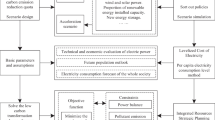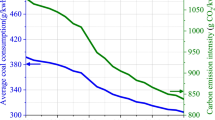Abstract
China has become the largest energy producer and consumer in the world. Its carbon emissions account for 80% of its total carbon emissions, while the carbon emissions caused by energy consumption in the power industry account for more than 50%. To ensure that the 2030 carbon-peak and 2060 carbon–neutral targets are achieved, it is imperative to carry out low-carbon energy transformation in the power industry. The paper compares and analyzes the technical level of six high-energy-consuming industries: power, steel, cement, aluminum smelting, petrochemical industry, and coal chemical industry in terms of low carbon. The results show that the structural adjustment of China’s high-energy-consuming industries has reached the upper limit, and the low-carbon transformation of power and energy has become inevitable. The carbon emissions of China’s six regional power grids are statistically analyzed. The background of the power generation proportion of China’s thermal power, hydropower, nuclear power, wind power, solar power and other different energy systems from 2018 to 2020 is analyzed, and the development trend is predicted. The low-carbon emission path of power energy is proposed. Based on the EnergyPLAN model, the power energy structure of carbon peaking in different scenarios from 2020 to 2030 is constructed, and the power energy system’s carbon dioxide emission reduction paths under different scenarios are obtained. The sustainability impact of different power generation combination scenarios is comprehensively evaluated using the multi-index evaluation method, and the optimal path of the power system to energy scenario is selected. The research conclusion provides a basis for the power sector’s renewable energy power generation path selection.






Similar content being viewed by others
Data availability
The data can be available on request.
References
Abbas Q, Nurunnabi M, Alfakhri Y, Khan W, Hussain A, Iqbal W (2020) The role of fixed capital formation, renewable and non-renewable energy in economic growth and carbon emission: a case study of Belt and Road Initiative project. Environ Sci Pollut Res 27:45476–45486. https://doi.org/10.1007/s11356-020-10413-y
Calise F, Ge L, Du T, Li C, Li Y, Yan J, Rafiq MU (2022) Virtual collection for distributed photovoltaic data: challenges, methodologies, and applications. Energies 15:8783. https://doi.org/10.3390/EN15238783
Cao J, Dai H, Li S, Guo C, Ho M, Cai W, He J, Huang H, Li J, Liu Y, Qian H, Wang C, Wu L, Zhang X (2021) The general equilibrium impacts of carbon tax policy in China: a multi-model comparison. Energy Econ 99:105284. https://doi.org/10.1016/j.eneco.2021.105284
Cao B, Yan Y, Wang Y, Liu X, Lin JCW, Sangaiah AK, Lv Z (2022) A multiobjective intelligent decision-making method for multistage placement of PMU in power grid enterprises. IEEE Trans Ind Informatics. https://doi.org/10.1109/TII.2022.3215787
Dong F, Zhu J, Li Y, Chen Y, Gao Y, Hu M, Qin C, Sun J (2022) How green technology innovation affects carbon emission efficiency: evidence from developed countries proposing carbon neutrality targets. Environ Sci Pollut Res 29:35780–35799. https://doi.org/10.1007/s11356-022-18581-9
Ge L, Li Y, Li Y, Yan J, Sun Y (2022) Smart distribution network situation awareness for high-quality operation and maintenance: a brief review. Energies 15(3):828. https://doi.org/10.3390/en15030828
Han Y, Tan S, Zhu C, Liu Y (2022) Research on the emission reduction effects of carbon trading mechanism on power industry: plant-level evidence from China. Int J Clim Chang Strateg. Manag. ahead-of-print. https://doi.org/10.1108/IJCCSM-06-2022-0074/FULL/PDF
Hou Y, Iqbal W, Shaikh GM, Iqbal N, Solangi YA, Fatima A (2019) Measuring energy efficiency and environmental performance: a case of South Asia. Processes 7:325. https://doi.org/10.3390/pr7060325
Huang W, Saydaliev HB, Iqbal W, Irfan M (2022a) Measuring the impact of economic policies on Co2 emissions: ways to achieve green economic recovery in the post-Covid-19 era. Clim Chang Econ 13(03):2240010. https://doi.org/10.1142/S2010007822400103
Huang X, Chau KY, Tang YM, Iqbal W (2022b) Business ethics and irrationality in SME during COVID-19: does it impact on sustainable business resilience? Front Environ Sci 10:275. https://doi.org/10.3389/fenvs.2022.870476
Iqbal W, Yumei H, Abbas Q, Hafeez M, Mohsin M, Fatima A, Jamali MA, Jamali M, Siyal A, Sohail N (2019) Assessment of wind energy potential for the production of renewable hydrogen in Sindh Province of Pakistan. Processes 7(4):196. https://doi.org/10.3390/pr7040196
Iqbal W, Fatima A, Yumei H, Abbas Q, Iram R (2020) Oil supply risk and affecting parameters associated with oil supplementation and disruption. J Clean Prod 255. https://doi.org/10.1016/j.jclepro.2020.120187
Iqbal N, Abbasi KR, Shinwari R, Guangcai W, Ahmad M, Tang K (2021) Does exports diversification and environmental innovation achieve carbon neutrality target of OECD economies? J Environ Manage 291. https://doi.org/10.1016/j.jenvman.2021.112648
Khan SAR, Ponce P, Yu Z (2021) Technological innovation and environmental taxes toward a carbon-free economy: an empirical study in the context of COP-21. J Environ Manage 298:113418. https://doi.org/10.1016/j.jenvman.2021.113418
Li J, Wang Y, Nguyen X, Zhuang X, Li Jiancheng, Querol X, Li B, Moreno N, Hoang V, Cordoba P, Do V (2022a) First insights into mineralogy, geochemistry, and isotopic signatures of the Upper Triassic high-sulfur coals from the Thai Nguyen Coal field, NE Vietnam. Int J Coal Geol 261:104097. https://doi.org/10.1016/J.COAL.2022.104097
Li X, Wang H, Yang C (2022b) Driving mechanism of digital economy based on regulation algorithm for development of low-carbon industries. Sustain Energy Technol Assess 102909. https://doi.org/10.1016/J.SETA.2022.102909
Liu H, Tang YM, Iqbal W, Raza H (2022) Assessing the role of energy finance, green policies, and investment towards green economic recovery. Environ Sci Pollut Res 29:21275–21288. https://doi.org/10.1007/s11356-021-17160-8
Ma Q, Murshed M, Khan Z (2021) The nexuses between energy investments, technological innovations, emission taxes, and carbon emissions in China. Energy Policy 155:112345. https://doi.org/10.1016/j.enpol.2021.112345
Ma Q, Tariq M, Mahmood H, Khan Z (2022) The nexus between digital economy and carbon dioxide emissions in China: the moderating role of investments in research and development. Technol Soc 68:101910. https://doi.org/10.1016/j.techsoc.2022.101910
Mohsin M, Ullah H, Iqbal N, Iqbal W, Taghizadeh-Hesary F (2021) How external debt led to economic growth in South Asia: a policy perspective analysis from quantile regression. Econ Anal Policy 72:423–437. https://doi.org/10.1016/j.eap.2021.09.012
Nakhli MS, Shahbaz M, Ben Jebli M, Wang S (2022) Nexus between economic policy uncertainty, renewable & non-renewable energy and carbon emissions: contextual evidence in carbon neutrality dream of USA. Renew Energy 185:75–85. https://doi.org/10.1016/j.renene.2021.12.046
Shan S, Genç SY, Kamran HW, Dinca G (2021) Role of green technology innovation and renewable energy in carbon neutrality: a sustainable investigation from Turkey. J Environ Manage 294:113004. https://doi.org/10.1016/j.jenvman.2021.113004
Shao X, Zhong Y, Liu W, Li RYM (2021) Modeling the effect of green technology innovation and renewable energy on carbon neutrality in N-11 countries? Evidence from advance panel estimations. J Environ Manage 296:113189. https://doi.org/10.1016/j.jenvman.2021.113189
Umar M, Ji X, Mirza N, Naqvi B (2021) Carbon neutrality, bank lending, and credit risk: evidence from the Eurozone. J Environ Manage 296:113156. https://doi.org/10.1016/j.jenvman.2021.113156
Wang P, Yu P, Huang L, Zhang Y (2022a) An integrated technical, economic, and environmental framework for evaluating the rooftop photovoltaic potential of old residential buildings. J Environ Manage 317:115296. https://doi.org/10.1016/J.JENVMAN.2022a.115296
Wang P, Yu P, Lu J, Zhang Y (2022b) The mediation effect of land surface temperature in the relationship between land use-cover change and energy consumption under seasonal variations. J Clean Prod 340:130804. https://doi.org/10.1016/J.JCLEPRO.2022b.130804
Wang Y, Cao Q, Liu L, Wu Y, Liu H, Gu Z, Zhu C (2022c) A review of low and zero carbon fuel technologies: achieving ship carbon reduction targets. Sustain Energy Technol Assess 54:102762. https://doi.org/10.1016/J.SETA.2022.102762
Wang Y, Wen X, Gu B, Gao F (2022d) Power scheduling optimization method of wind-hydrogen integrated energy system based on the improved AUKF algorithm. Math 10:4207. https://doi.org/10.3390/MATH10224207
Xiang H, Chau KY, Iqbal W, Irfan M, Dagar V (2022) Determinants of social commerce usage and online impulse purchase: implications for business and digital revolution. Front Psychol 13:837042. https://doi.org/10.3389/fpsyg.2022.837042
Xu W, Xie Y, Xia D, Ji L, Huang G (2021a) A multi-sectoral decomposition and decoupling analysis of carbon emissions in Guangdong province, China. J Environ Manage 298:113485. https://doi.org/10.1016/J.JENVMAN.2021.113485
Xu X, Wang C, Zhou P (2021b) GVRP considered oil-gas recovery in refined oil distribution: from an environmental perspective. Int J Prod Econ 235:108078. https://doi.org/10.1016/J.IJPE.2021.108078
Yang C, Hao Y, Irfan M (2021a) Energy consumption structural adjustment and carbon neutrality in the post-COVID-19 era. Struct Chang Econ Dyn 59:442–453. https://doi.org/10.1016/j.strueco.2021.06.017
Yang Z, Zhang M, Liu L, Zhou D (2022a) Can renewable energy investment reduce carbon dioxide emissions? Evidence from scale and structure. Energy Econ 112:106181. https://doi.org/10.1016/J.ENECO.2022a.106181
Yang Z, Zhang M, Liu L, Zhou D (2022b) Can renewable energy investment reduce carbon dioxide emissions? Evidence from scale and structure. Energy Econ 112:106181. https://doi.org/10.1016/J.ENECO.2022b.106181
Yu J, Tang YM, Chau KY, Nazar R, Ali S, Iqbal W (2022) Role of solar-based renewable energy in mitigating CO2 emissions: evidence from quantile-on-quantile estimation. Renew Energy 182:216–226. https://doi.org/10.1016/j.renene.2021.10.002
Zhou S, Wang J, Liang Y (2021) Development of China’s natural gas industry during the 14th Five-Year Plan in the background of carbon neutrality. Nat Gas Ind. https://doi.org/10.3787/j.issn.1000-0976.2021.02.020
Zhou Y, Zou S, Duan W, Chen Y, Takara K, Di Y (2022) Analysis of energy carbon emissions from agroecosystems in Tarim River Basin, China: a pathway to achieve carbon neutrality. Appl Energy 325:119842. https://doi.org/10.1016/J.APENERGY.2022.119842
Author information
Authors and Affiliations
Contributions
Bo Wang: conceptualization, data curation, methodology, writing—original draft, data curation, visualization, supervision, editing, writing—review and editing, and software.
Corresponding author
Ethics declarations
Ethical approval and consent to participate
The authors declare that they have no known competing financial interests or personal relationships that seem to affect the work reported in this article. We declare that we have no human participants, human data, or human tissues.
Consent for publication
N/A
Competing interests
The authors declare no competing interests.
Additional information
Responsible Editor: Philippe Garrigues
Publisher's note
Springer Nature remains neutral with regard to jurisdictional claims in published maps and institutional affiliations.
Rights and permissions
Springer Nature or its licensor (e.g. a society or other partner) holds exclusive rights to this article under a publishing agreement with the author(s) or other rightsholder(s); author self-archiving of the accepted manuscript version of this article is solely governed by the terms of such publishing agreement and applicable law.
About this article
Cite this article
Wang, B. Low-carbon transformation planning of China’s power energy system under the goal of carbon neutrality. Environ Sci Pollut Res 30, 44367–44377 (2023). https://doi.org/10.1007/s11356-023-25279-z
Received:
Accepted:
Published:
Issue Date:
DOI: https://doi.org/10.1007/s11356-023-25279-z




